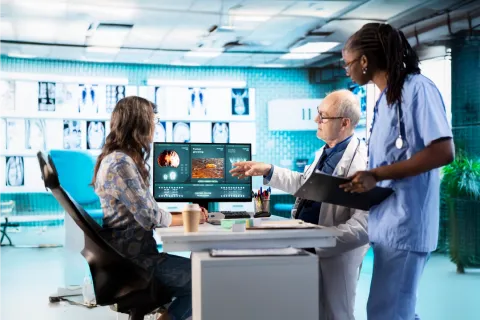
In the ever-evolving healthcare landscape, personalized medical devices have emerged as a groundbreaking approach, tailoring treatments to individual patients based on their unique characteristics. These include devices that are custom-made or personalized to be adaptable to the patients’ solutions.
What are Personalized Devices?
Personalized medical devices are tailored to meet the specific needs of individual patients’ and range from simple items like shoe inserts to complex implants. These devices are produced using various technologies, including 3D printing, and may incorporate human tissues. Personalized medical devices fall into three (03) categories: custom-made, patient-matched, and adaptable.
What are Custom-made, Patient-matched, and Adaptable Devices?
Custom-made medical devices are designed for the sole use of an individual or a healthcare professional and it is designed and made in accordance with a written request of an authorized professional. It is designed in a specific manner to meet the specific anatomical/physiological feature or pathological condition of the individual.
Medical devices that are patient-matched, adaptable, or mass-produced cannot be considered to be custom-made.
Personalized medical devices include custom-made but also cover patient-matched and adaptable devices.
Patient-matched Devices: These devices are made to match a patient’s anatomy with a specific design envelope technique. These are generally manufactured in batches so that they can be validated and reproduced. The device is designed and produced by a manufacturer after consultation with the respective authorized healthcare professional.
Adaptable Medical Devices: These are medical devices that are mass-produced. It is adapted, adjusted, and assembled at the Point of Care (POC) as per the manufacturer's instructions to suit an individual patient’s needs.
Examples of Personalized Medical Devices:
Custom-made Devices: Artificial cervical disc replacements and prosthetic eyes, etc.
Patient-matched Devices: 3D-printed orthopaedic implants and custom contact lenses.
Adaptable Devices: Adjustable wheelchairs and hearing aids, devices with human-origin materials like hernia meshes, and those made with advanced manufacturing like limb endoprostheses and thermoformed polymeric implants.
What is the Regulatory Pathway for Personalized Medical Devices?
The Regulatory pathway for personalized medical devices, including custom-made, adaptable, and patient-matched devices, ensures they meet safety and performance standards tailored to an individual patient’s needs.
Custom-made devices are made to a healthcare professional's specifications for a specific patient and may have exemptions but they must still be safe and effective.
Regulatory Requirements:
- The manufacturer must have clear documentation that is required for custom-made devices, which includes document requests and specific design specifications from an authorized health professional.
- Identify the appropriate classification of the device and prepare the Regulatory needs for the specific risk class identified.
- The device must meet the general safety and performance requirements.
- Perform appropriate risk analysis and related documentation.
- The manufacturers must have a Quality Management System (QMS) established for the custom-made device, and for devices of higher risk class, the QMS has to be verified by a third-party agency.
- Manufacturers must notify or register their custom-made device with the Regulatory authority in the jurisdiction applied.
- Manufacturers must have a Post-market Surveillance (PMS) established for the device with corrective action and Adverse Event Reporting (AER).
Adaptable medical devices are mass-produced and must follow the usual Regulatory requirements to obtain pre-market approval, according to their risk classification, in the jurisdiction in which they are supplied. The manufacturer of an adaptable device should provide instructions on how to assemble or shape the device.
Patient-matched devices are made within a design envelope to fit a patient’s anatomy or condition, designed by manufacturers, and produced through validated processes under Regulatory oversight. Their pathway requires the device to be classified correctly and must have the usual Regulatory requirements for pre-market approval based on the device’s risk classification.
The manufacturer must meet both pre- and post-market Regulatory requirements in the jurisdiction where the device is supplied. These include:
- Clinical performance.
- Compliance with safety and performance standards.
- Compliance with manufacturing standards.
- Provisions on the label and information.
- Registration.
- Post-market Surveillance (PMS)
- Corrective action and AER.
This shift towards personalized care has given rise to a new generation of medical devices designed to meet specific patient needs. However, with innovation comes responsibility, and the European Union (EU) Medical Device Regulation (MDR) 2017/745 and In Vitro Diagnostic Regulation (IVDR) 2017/746 have set stringent standards to ensure the safety and efficacy of these devices.
Under the EU MDR (Medical Device Regulation) and IVDR (In Vitro Diagnostic Medical Device Regulation), the verification and validation processes for personalized medical devices involve several steps to ensure that the devices meet the required safety and performance standards.
Medical Device Verification and Verification: It involves ensuring that design outputs meet the specified requirements. It includes conducting tests and examining to ensure that manufacturers manufacture in accordance with the specifications. Verification includes design reviews, compliance checks, and physical tests. Validation ensures the devices meet the user requirements, which involve activities like clinical evaluation, safety, and effectiveness.
This involves a series of steps, including
Specified Design: For patient-matched medical devices, it is not possible to assess each device’s compliance with safety and performance due to variations in the patient’s anatomy. This helps in compliance with Essential Principles.
Device Description: Manufacturers are required to describe the patient's medical device which includes the patient-matched medical device for intended use. This involves consulting with healthcare professionals and at the same time manufacturer adherence to hold complete responsibility for the design and manufacture.
Design Scheme: Manufacturers must identify and establish boundaries to characterize patient-matched medical devices for production purposes. There are many parameters like structural parameters, material parameters, performance parameters, etc.
Verification and Validation Activities: These activities should be based on the risk management requirements and QMS procedure, which indicates that they meet the user requirements and intended uses in a controlled process.
Personalized medical devices, guided by stringent EU regulations, demand meticulous verification, validation, and PMS for effectiveness. We understand that this step is crucial and can sometimes be challenging in the Regulatory lifecycle. Connect with our Regulatory Experts for assistance. Stay informed. Stay compliant.









